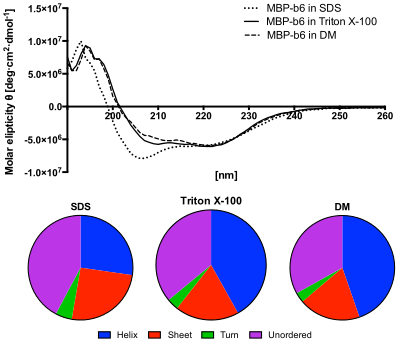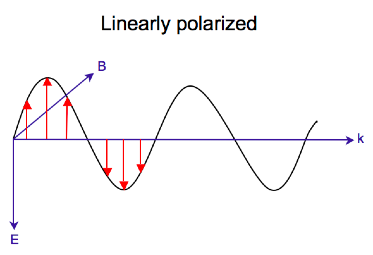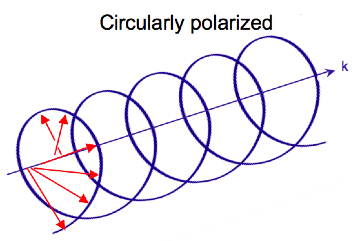Circular dichroism
Circular dichroism (CD) is
Physical principles
Circular polarization of light
Electromagnetic radiation consists of an electric and magnetic field that oscillate perpendicular to one another and to the propagating direction,[7] a transverse wave. While linearly polarized light occurs when the electric field vector oscillates only in one plane, circularly polarized light occurs when the direction of the electric field vector rotates about its propagation direction while the vector retains constant magnitude. At a single point in space, the circularly polarized-vector will trace out a circle over one period of the wave frequency, hence the name. The two diagrams below show the electric field vectors of linearly and circularly polarized light, at one moment of time, for a range of positions; the plot of the circularly polarized electric vector forms a helix along the direction of propagation . For left circularly polarized light (LCP) with propagation towards the observer, the electric vector rotates counterclockwise.[2] For right circularly polarized light (RCP), the electric vector rotates clockwise.
Interaction of circularly polarized light with matter
When circularly polarized light passes through an absorbing optically active medium, the speeds between right and left polarizations differ () as well as their wavelength() and the extent to which they are absorbed (). Circular dichroism is the difference .
The rotational strength has also been determined theoretically,
We see from these two equations that in order to have non-zero , the electric and magnetic dipole moment operators ( and ) must transform as the same irreducible representation. and are the only
Simply put, since circularly polarized light itself is "chiral", it interacts differently with chiral molecules. That is, the two types of circularly polarized light are absorbed to different extents. In a CD experiment, equal amounts of left and right circularly polarized light of a selected wavelength are alternately radiated into a (chiral) sample. One of the two polarizations is absorbed more than the other one, and this wavelength-dependent difference of absorption is measured, yielding the CD spectrum of the sample. Due to the interaction with the molecule, the electric field vector of the light traces out an elliptical path after passing through the sample.
It is important that the chirality of the molecule can be conformational rather than structural. That is, for instance, a protein molecule with a helical secondary structure can have a CD that changes with changes in the conformation.
Delta absorbance
By definition,
where (Delta Absorbance) is the difference between absorbance of left circularly polarized (LCP) and right circularly polarized (RCP) light (this is what is usually measured). is a function of wavelength, so for a measurement to be meaningful the wavelength at which it was performed must be known.
Molar circular dichroism
It can also be expressed, by applying
where
- and are the molar extinction coefficients for LCP and RCP light,
- is the molar concentration,
- is the path length in centimeters (cm).
Then
is the molar circular dichroism. This intrinsic property is what is usually meant by the circular dichroism of the substance. Since is a function of wavelength, a molar circular dichroism value () must specify the wavelength at which it is valid.
Extrinsic effects on circular dichroism
In many practical applications of circular dichroism (CD), as discussed below, the measured CD is not simply an intrinsic property of the molecule, but rather depends on the molecular conformation. In such a case the CD may also be a function of temperature, concentration, and the chemical environment, including solvents. In this case the reported CD value must also specify these other relevant factors in order to be meaningful.
In ordered structures lacking two-fold rotational symmetry, optical activity,
Molar ellipticity
Although is usually measured, for historical reasons most measurements are reported in degrees of ellipticity. Molar ellipticity is circular dichroism corrected for concentration. Molar circular dichroism and molar ellipticity, , are readily interconverted by the equation:

This relationship is derived by defining the ellipticity of the polarization as:
where
- and are the magnitudes of the vectorsof the right-circularly and left-circularly polarized light, respectively.
When equals (when there is no difference in the absorbance of right- and left-circular polarized light), is 0° and the light is linearly polarized. When either or is equal to zero (when there is complete absorbance of the circular polarized light in one direction), is 45° and the light is circularly polarized.
Generally, the circular dichroism effect is small, so is small and can be approximated as in radians. Since the intensity or irradiance, , of light is proportional to the square of the electric-field vector, the ellipticity becomes:
Then by substituting for I using Beer's law in natural logarithm form:
The ellipticity can now be written as:
Since , this expression can be approximated by expanding the exponentials in a Taylor series to first-order and then discarding terms of in comparison with unity and converting from radians to degrees:
The linear dependence of solute concentration and pathlength is removed by defining molar ellipticity as,
Then combining the last two expression with Beer's law, molar ellipticity becomes:
The units of molar ellipticity are historically (deg·cm2/dmol). To calculate molar ellipticity, the sample concentration (g/L), cell pathlength (cm), and the molecular weight (g/mol) must be known.
If the sample is a protein, the mean residue weight (average molecular weight of the amino acid residues it contains) is often used in place of the molecular weight, essentially treating the protein as a solution of amino acids. Using mean residue ellipticity facilitates comparing the CD of proteins of different molecular weight; use of this normalized CD is important in studies of protein structure.
Mean residue ellipticity
Methods for estimating secondary structure in polymers, proteins and polypeptides in particular, often require that the measured molar ellipticity spectrum be converted to a normalized value, specifically a value independent of the polymer length. Mean residue ellipticity is used for this purpose; it is simply the measured molar ellipticity of the molecule divided by the number of monomer units (residues) in the molecule.
Application to biological molecules

Lower panel: The content of secondary structures predicted from the CD spectra using the CDSSTR algorithm. The protein in SDS solution shows increased content of unordered structures and decreased helices content.[12]
In general, this phenomenon will be exhibited in absorption bands of any
CD is closely related to the
The far-UV (
The near-UV CD spectrum (>250 nm) of proteins provides information on the
Visible CD spectroscopy is a very powerful technique to study metal–protein interactions and can resolve individual d–d electronic transitions as separate bands. CD spectra in the visible light region are only produced when a metal ion is in a chiral environment, thus, free metal ions in solution are not detected. This has the advantage of only observing the protein-bound metal, so pH dependence and stoichiometries are readily obtained. Optical activity in transition metal ion complexes have been attributed to configurational, conformational and the vicinal effects. Klewpatinond and Viles (2007) have produced a set of empirical rules for predicting the appearance of visible CD spectra for Cu2+ and Ni2+ square-planar complexes involving histidine and main-chain coordination.
CD gives less specific structural information than
CD spectroscopy is usually used to study proteins in solution, and thus it complements methods that study the solid state. This is also a limitation, in that many proteins are embedded in membranes in their native state, and solutions containing membrane structures are often strongly scattering. CD is sometimes measured in thin films.
CD spectroscopy has also been done using semiconducting materials such as TiO2 to obtain large signals in the UV range of wavelengths, where the electronic transitions for biomolecules often occur.[18]
Experimental limitations
This article needs additional citations for verification. (March 2010) |
CD has also been studied in
Measurement of CD is also complicated by the fact that typical aqueous buffer systems often absorb in the range where structural features exhibit differential absorption of circularly polarized light.
In addition to measuring in aqueous systems, CD, particularly far-UV CD, can be measured in organic solvents e.g. ethanol, methanol,
It may be of interest to note that the protein CD spectra used in secondary structure estimation are related to the π to π* orbital absorptions of the
Once oxygen has been eliminated, perhaps the second most important technical factor in working below 200 nm is to design the rest of the optical system to have low losses in this region. Critical in this regard is the use of aluminized mirrors whose coatings have been optimized for low loss in this region of the spectrum.
The usual light source in these instruments is a high pressure, short-arc
Light from synchrotron sources has a much higher flux at short wavelengths, and has been used to record CD down to 160 nm. In 2010 the CD spectrophotometer at the electron storage ring facility ISA at the University of Aarhus in Denmark was used to record solid state CD spectra down to 120 nm.[19] At the
See also
- Chirality-induced spin selectivity
- Hyper Rayleigh scattering optical activity
- Linear dichroism
- Magnetic circular dichroism
- Optical activity
- Optical isomerism
- Optical rotation
- Optical rotatory dispersion
- Protein Circular Dichroism Data Bank
- Synchrotron radiation circular dichroism spectroscopy
- Two-photon circular dichroism
- Vibrational circular dichroism
References
- ISBN 978-0-7167-7329-0.
- ^ ISBN 978-0-471-97124-5. Retrieved 29 April 2011.
- ^ Introduction to Quantum Theory 2ED David Park Sec 2.2 Pg32 "...the polarization of a beam of light is exactly the same kind of thing as the spin of a beam of electrons, the differences of terminology reflecting only the accidents of the historical order of discovery."
- ISBN 978-0-306-45142-3. Retrieved 29 April 2011.
- ^ ISBN 978-1-56081-618-8. Retrieved 29 April 2011.
- PMID 17523638.
- ISBN 978-0-19-855897-2. Retrieved 29 April 2011.
- .
- .
- S2CID 117891131.
- hdl:10220/40854.
- PMID 25423011.
- (PDF) from the original on 2022-10-09.
- S2CID 19685126.
- PMID 17896349.
- PMID 17406547.
- ^ Bioinorganic Interface: Mechanistic Studies of Protein-Directed Nanomaterial Synthesis. (2016, May 5). Retrieved March 1, 2019, from https://pubs.acs.org/doi/pdf/10.1021/acs.jpcc.6b02569
- ^ Sarkar, Sumant, Ryan Behunin, and John G. Gibbs. "Shape-Dependent, Chiro-Optical Response of UV-Active, Nanohelix Metamaterials." Nano letters (2019). https://pubs.acs.org/doi/10.1021/acs.nanolett.9b03274
- PMID 20845349.[permanent dead link]
External links
- Circular Dichroism spectroscopy by Alliance Protein Laboratories, a commercial service provider
- An Introduction to Circular Dichroism Spectroscopy by Applied Photophysics, an equipment supplier
- An animated, step-by-step tutorial on Circular Dichroism and Optical Rotation by Prof Valev.


























![{\displaystyle [\theta ]}](https://wikimedia.org/api/rest_v1/media/math/render/svg/e1456b03b038385e3bc52344dbf1a9bfbc41b4cf)
![{\displaystyle [\theta ]=3298.2\,\Delta \varepsilon .\,}](https://wikimedia.org/api/rest_v1/media/math/render/svg/c66e42a40570e3d3cb312c0eadd95d59170dc258)











![{\displaystyle [\theta ]={\frac {100\theta }{Cl}}\,}](https://wikimedia.org/api/rest_v1/media/math/render/svg/ec21d26e0b12e81313ef0b42bbb5ec4f63369c3d)
![{\displaystyle [\theta ]=100\,\Delta \varepsilon \left({\frac {\ln 10}{4}}\right)\left({\frac {180}{\pi }}\right)=3298.2\,\Delta \varepsilon \,}](https://wikimedia.org/api/rest_v1/media/math/render/svg/88756c2cb3877d28ff0932ef432b0a5e4861ab58)